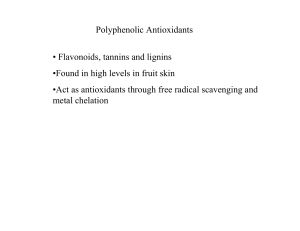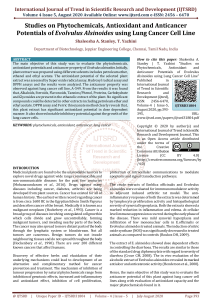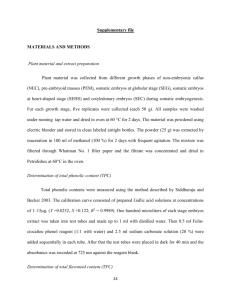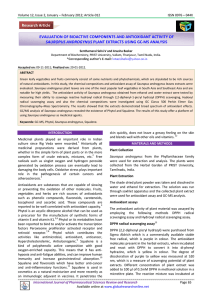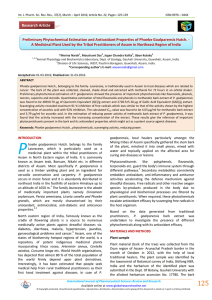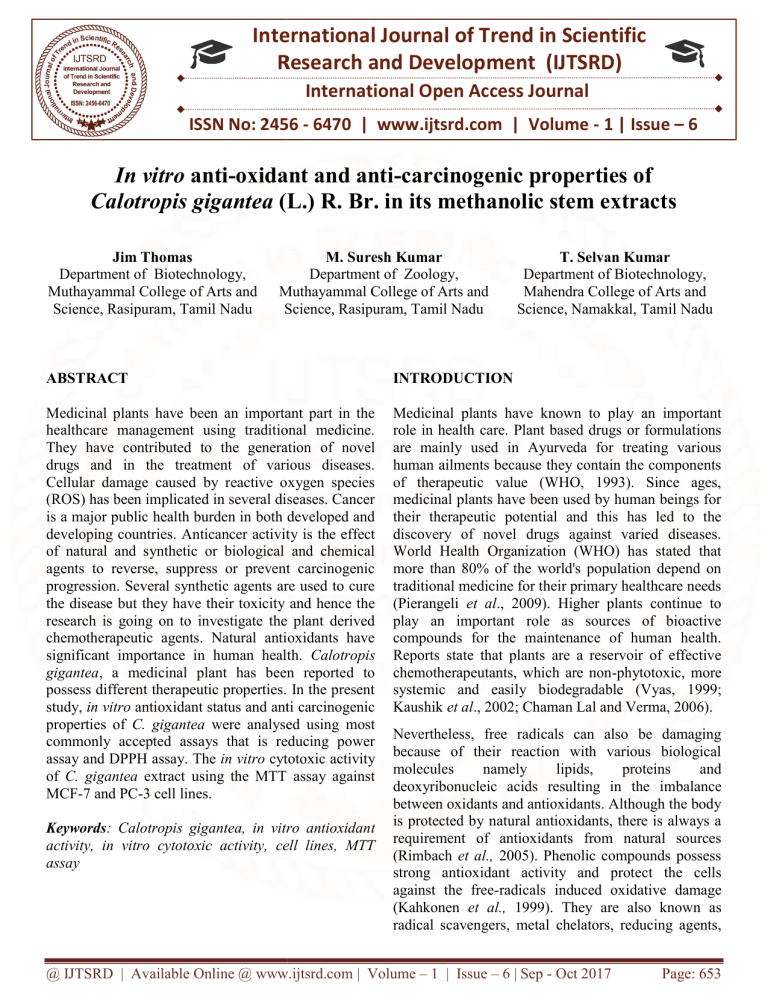
International Journal of Trend in Scientific
Research and Development (IJTSRD)
International Open Access Journal
ISSN No: 2456 - 6470 | www.ijtsrd.com | Volume - 1 | Issue – 6
In vitro anti-oxidant
oxidant and anti
anti-carcinogenic
carcinogenic properties of
Calotropis gigantea (L.) R. Br. in its methanolic stem extracts
Jim Thomas
Department of Biotechnology,
Muthayammal College of Arts and
Science, Rasipuram, Tamil Nadu
M. Suresh Kumar
Department of Zoology,
Muthayammal College of Arts and
Scien
Science, Rasipuram, Tamil Nadu
T. Selvan Kumar
Department of Biotechnology,
Mahendra
ahendra College of Arts and
Science,
nce, Namakkal,
Namakka Tamil Nadu
ABSTRACT
INTRODUCTION
Medicinal plants have been an important part in the
healthcare management using traditional medicine.
They have contributed to the generation of novel
drugs and in the treatment of various diseases.
Cellular damage caused by reactive oxygen species
(ROS) has been implicated in several diseases. Cancer
is a major public health burden in both developed and
developing countries. Anticancer activit
activity is the effect
of natural and synthetic or biological and chemical
agents to reverse, suppress or prevent carcinogenic
progression. Several synthetic agents are used to cure
the disease but they have their toxicity and hence the
research is going on to investigate
vestigate the plant derived
chemotherapeutic agents. Natural antioxidants have
significant importance in human health. Calotropis
gigantea,, a medicinal plant has been reported to
possess different therapeutic properties. In the present
study, in vitro antioxidant
oxidant status and anti carcinogenic
properties of C. gigantea were analysed using most
commonly accepted assays that is reducing power
assay and DPPH assay. The in vitro cytotoxic activity
of C. gigantea extract using the MTT assay against
MCF-7 and PC-3 cell lines.
Medicinal
edicinal plants have known to play an important
role in health care. Plant based drugs or formulations
are mainly used in Ayurveda for treating various
human ailments because they contain the components
of therapeutic value (WHO, 1993). Since ages,
medicinal plants have been used by human beings for
their therapeutic potential and this has led to the
discovery of novel drugs against varied diseases.
World Health Organization (WHO) has stated that
more than 80% of the world's population depend on
traditional medicine for their primary healthcare needs
(Pierangeli et al.,, 2009). Higher plants continue to
play an important role as sources of bioactive
compounds for the maintenance of human health.
Reports state that plants are a reservoir of effective
chemotherapeutants, which are non-phytotoxic,
non
more
systemic and easily biodegradable
iodegradable (Vyas, 1999;
Kaushik et al.,
., 2002; Chaman Lal and Verma, 2006).
Keywords: Calotropis gigantea, in vitro antioxidan
antioxidant
activity, in vitro cytotoxic activity, cell lines, MTT
assay
Nevertheless, free radicals can also be damaging
because of their reaction with various biological
molecules
namely
lipids,
proteins
and
deoxyribonucleic acids resulting in the imbalance
i
between oxidants and antioxidants. Although the body
is protected by natural antioxidants, there is always a
requirement of antioxidants from natural sources
(Rimbach et al., 2005). Phenolic compounds possess
strong antioxidant activity and protect
protec the cells
against the free-radicals
radicals induced oxidative damage
(Kahkonen et al., 1999). They are also known as
radical scavengers, metal chelators, reducing agents,
@ IJTSRD | Available Online @ www.ijtsrd.com | Volume – 1 | Issue – 6 | Sep - Oct 2017
Page: 653
International Journal of Trend in Scientific Research and Development (IJTSRD) ISSN: 2456-6470
hydrogen donors, and singlet oxygen quenchers
(Proestos et al., 2006).
using a rotary evaporator and stored at 4°C for further
use.
Antioxidants are those compounds which terminate
the attack of free radicals and thereby reduce the risk
of oxidative stress disorders (Rice-Evans et al., 1996).
They possess free radical chain reaction breaking
properties. Enzymes such as super-oxide dismutase,
catalase and antioxidant compounds viz. ascorbic
acid, tocopherol, phenolic acids, polyphenols,
flavonoids and glutathione protect organisms from
oxidative stress. Antioxidative defence mechanisms
are the most effective path to eliminate and diminish
the action of free radicals which cause the oxidative
stress. Plants have antioxidant activities that can be
helpful in reducing such free radical induced tissue
injury (Kanatt et al., 2007).
Reducing Power Assay
Cancer is a group of diseases which are characterized
by uncontrolled growth and spread of abnormal cells,
which if not controlled, can result in death. They are
characterized by abnormal multiplication of cells.
They are the second cause of mortality after
cardiovascular diseases in developed countries and the
third after infectious and cardiovascular diseases in
developing countries (Bieche, 2004; Mbaveng et al.,
2011).
Calotropis gigantea (L.)R.Br. are glabrous or hoary,
lactiferous shrubs or small trees, about 3-4 m tall
commonly known as the swallow-wort or milkweed.
Its stems are erect, up to 20 cm in diameter. The
leaves are broadly elliptical to oblong obviate in
shape, with the size of 9-20 cm x 6-12.5 cm but
subsessile. The cymes are 5-12.5 cm in diameter. The
inflorescence stalk is between 5-12 cm long, the stalk
of an individual flower is 2.5-4 cm long. Sepal lobes
are broadly egg shaped with a size of 4-6 mm x 2-3
mm. Petal is 2.5-4 cm in diameter. In the present
study, the in vitro antioxidant and cytotoxic activity of
the C. gigantea methanolic stem extract were studied
using the MTT assay against MCF-7 and PC-3 DLA.
Materials and Methods
Sample Preparation
Healthy parts of stem were shade dried and powdered
from samples of C. gigantea (L.) R.Br. collected from
Namakkal District, Tamil Nadu. Methanolic solvent
stem extract was prepared using Soxhlet extraction
method. The process was carried out overnight to
obtain the necessary extract which was concentrated
A method developed by Oyaizu, 1986 for reducing
power test was used. The above sample including
extract together with Ascorbic acid solutions were
spiked with 2.5ml of phosphate buffer (0.2 M, pH 6.6)
and 2.5ml of 1% potassium ferricyanide. The mixture
was then kept in a 50°C water-bath for 20min. The
resulting solution was then cooled rapidly, spiked
with 2.5ml of 10% trichloroacetic acid, and
centrifuged at 3000rpm for 10 min. The supernatant
(5ml) was then mixed with 5ml of distilled water and
1ml of 0.1% ferric chloride. The absorbance at 700nm
was then detected after reaction for 10min. The higher
the absorbance represents the stronger the reducing
power. The reducing power assay was expressed in
terms of Ascorbic acid equivalent per gram of dry
weight basis.
DPPH Activity
DPPH radical scavenging activity was carried out by
the method of Molyneux (2004). To 1.0 ml of 100.0
μM DPPH solution in methanol, equal volume of the
sample in methanol of different concentration was
added and incubated in dark for 30 minutes. The
change in coloration was observed in terms of
absorbance using a spectrophotometer at 514 nm. 1.0
ml of methanol instead of test sample was added to
the control tube. The different concentration of
ascorbic acid was used as reference compound.
Percentage of inhibition was calculated from the
equation [(Absorbance of control - Absorbance of
test)/ Absorbance of control)] × 100. IC50 value was
calculated using Graph pad prism 5.0.
MTT Assay
Cell Lines and Culture Medium
MCF-7 (Human, Breast cancer) & PC – 3 (Human
prostate cancer cell line) cell cultures were procured
from National Centre for Cell Sciences (NCCS),
Pune, India. Stock cells were cultured in Dulbecco’s
modified Eagle’s medium (DMEM). Medium was
supplemented with 10% inactivated Fetal Bovine
Serum (FBS), penicillin (100 IU/ml), streptomycin
(100 g/ml) and amphotericin B (5 g/ml) in an
humidified atmosphere of 5% CO2 at 37C until
confluent. The cells were dissociated with TPVG
solution (0.2% trypsin, 0.02% EDTA, 0.05% glucose
@ IJTSRD | Available Online @ www.ijtsrd.com | Volume – 1 | Issue – 6 | Sep - Oct 2017
Page: 654
International Journal of Trend in Scientific Research and Development (IJTSRD) ISSN: 2456-6470
2456
in PBS). Thee stock cultures were grown in 25 cm 2
culture flasks and all experiments were carried out in
96 microtitre plates (Tarsons India Pvt. Ltd., Kolkata,
India).
Preparation of Test Solutions
For cytotoxicity studies, each weighed test drugs were
separately dissolved
solved in distilled DMSO and volume
was made up with DMEM supplemented with 2%
inactivated FBS to obtain a stock solution of 1 mg/ml
concentration and sterilized by filtration. Serially two
fold dilutions were prepared from this for carrying out
cytotoxic studies.
Determination of Cell Viability by MTT Assays
The monolayer cell culture was trypsinized and the
cell count was adjusted to 1.0 x 105 cells/ml using
medium containing 10% FBS and were used for the
determination of cell viability by MTT assays as
described
escribed by Francis and Rita (1986) respectively.
The absorbance was measured using a microplate
reader at a wavelength of 540 nm. The percentage
growth inhibition was calculated using the following
formula and concentration of test drug needed to
inhibit cell growth by 50% (CTC50) values is
generated from the dose-response
response curves for each cell
line.
% Growth inhibition =
Results and discussion
In vitro antioxidant activity
There is increasing evidence that antioxidants may be
useful in preventing the deleterious consequences of
oxidative stress and there is increasing interest in the
protective biochemical functions of natural
antioxidants contained in spices, herbs and medicinal
plants (Osawa, 1994; Noda et al.,., 1997).
Reducing power Assay
There are several other mechanisms by which
antioxidants can act. One of them is by scavenging of
reactive oxygen and nitrogen free radicals. There are
many different experimental methods by which the
free radical scavenging activity can be estimated. One
such method, by which total free radical scavenging
can be evaluated, is by determining their efficiency to
scavenge DPPH radicals. This method is based on the
reduction of DPPH, a stable free radical and any
molecule that can donate an electron or hydroge
hydrogen to
DPPH can react with it and thereby bleach the DPPH
absorption. Because of its odd electron, DPPH gives a
strong absorption maximum at 514nm by visible
spectroscopy (purple colour). As the odd electron of
the radical becomes paired off in the presence of a
hydrogen donor, that is, a free radical scavenging
antioxidant, the absorption strength is decreased and
the resulting decolorization is stoichiometric with
respect to the number of electrons captured (Blios,
1958) therefore when the C. gigantea methanol
extract were tested for the DPPH free radical
scavenging ability, the methanolic extract of C.
gigantea at showed strong radical scavenging activity
with Inhibition percentage of 196.38 µg/ml (Table 2,
Fig. 1). Whereas the reducing power assay shows the
th
inhibition percentage as 505.14 µg/ml (Table 1, Fig.
1).
In vitro anticancer activity
In this study, the cytotoxicity of the cell lines used
was found to be increasing with increasing extract
concentration. There was a reduction in viability i.e.,
16%
% and 27% in the case of PC3 and MCF7 cell lines
respectively. This result was in hand with the previous
reports. In spite of the development in the cancer
therapies, the mortality rate associated with cancer has
always stayed high. Thus, with regard to the
th present
scenario and the toxic side effects associated with the
available treatments, there is a need for alternative
methods which have higher efficacy and lesser toxic
side effects. Plants are considered as the best
substitute and many have been evaluated
evalua
in order to
discover novel, potential anticarcinogenic compounds
with no toxic effects (Gullett et al., 2010; Shah et al.,
2013). Two main strategies adopted for the selection
of plants species used in anticarcinogenic drug
discovery are random screening
screeni and ethno medicinal
knowledge. The second approach is the use of plants
of traditional medical systems like herbalism and
folklore (Pieters and Vlietnick, 2005). The cell lines
obtained from tumors help to investigate tumor cells
in a simplified and controlled
trolled environment (Makari et
al., 2008). In the cancer drug discovery program,
instead of mass screening of plant species, methods
based on ethnobotanical and ethnopharmacological
@ IJTSRD | Available Online @ www.ijtsrd.com | Volume – 1 | Issue – 6 | Sep - Oct 2017
Page: 655
International Journal of Trend in Scientific Research and Development (IJTSRD) ISSN: 2456-6470
data would be more economical and beneficial for
identifying potential anticancer molecules (Merghoub
et al., 2009). Investigating the cellular growth control
mechanisms have helped to understand carcinogenesis
and to identify compounds with specific antitumor
activities. Therefore, important preliminary data are
provided by cytotoxicity screening models which help
to select plant extracts with potential antitumor
properties for future studies (Cardellina et al., 1999).
Tables and Figures
Concentration
OD Value
% IC50
50
0.193
32.19
100
0.198
35.61
250
0.218
49.31
750
0.225
59.10
1000
0.237
62.32
IC50
505.14
Table 1 : Reducing power Assay
Figure 1: RP Assay of antioxidant activity of C.gigantea methanolic stem extract – graph
Concentration
OD Value
% IC50
50
0.189
40.00
100
0.192
42.20
250
0.217
60.74
750
0.219
62.22
1000
0.225
66.66
IC50
196.38
Table 2 : DPPH Assay
@ IJTSRD | Available Online @ www.ijtsrd.com | Volume – 1 | Issue – 6 | Sep - Oct 2017
Page: 656
International Journal of Trend in Scientific Research and Development (IJTSRD) ISSN: 2456-6470
Figure 2: DPPH Assay of antioxidant activity of C.gigantea methanolic stem extract – graph
Concentration
OD Value
%CTC50
CTC50
Control
0.573
-
-
50
0.373
34.90
65.10
250
0.328
42.76
500
0.254
55.67
44.33
750
0.186
67.53
32.47
1000
0.095
83.42
16.58
375.04
Cell Viability
57.24
Table.3 Anti tumor activity of C.gigantea methanolic stem extract against PC3cell line
Figure 3: Anti tumor activity of C.gigantea methanolic stem extract against PC cell lines - graph
@ IJTSRD | Available Online @ www.ijtsrd.com | Volume – 1 | Issue – 6 | Sep - Oct 2017
Page: 657
International Journal of Trend in Scientific Research and Development (IJTSRD) ISSN: 2456-6470
Concentration
OD Value
%CTC50
CTC50
Control
0.573
-
-
50
0.461
19.54
80.46
250
0.377
34.20
500
0.301
47.46
52.54
750
0.268
53.22
46.78
1000
0.157
72.60
27.40
598.17
Cell Viability
65.80
Table.4 Anti tumor activity of C.gigantea methanolic stem extract against MCF7 cell lines
Figure 3: Anti tumor activity of C.gigantea methanolic stem extract against PC cell lines - graph
Conclusion
The methanolic extract of C. gigantean was found as
an effective antioxidant agent with free reducing
activity as well as DPPH activity. The extract
exhibited a significant antitumor activity against the
cell lines tested. There was a reduction of viability to
16% and 27% in case of Cell line PC3 and MCF7
respectively.
References:
1) Blios MS. Antioxidant Determinations by the Use
of a Stable Free Radical. Nature 1958; 181: 11991200.
2) C. Proestos, I.S. Boziaris, G.J.E. Nychas, M. Kom
aitis. Analysis of flavonoids and phenolic acids in
Greek aromatic plants: investigation of their
antioxidant capacity and antimicrobial activity
Food Chem., 95 (2006), pp. 664-671.
3) Cardellina, J.H., Fuller, R.W., Gamble, W.R.,
Westergaard, C., Boswell, J., Munro, M.H.G.,
Currens, M. Boyd, M.P. (1999). Evolving
strategies for the selection de-replication and
prioritization of antitumor and HIV inhibitory
natural products extracts. (Eds. Bohlin, L. and
Bruhn, J.G.) Bioassay Methods in Natural Product
Research and Development, Kluwer Academic
Publishers, Dordrecht, p.25-36.
4) Chaman Lal and Verma LR: Use of certain bioproducts for insect-pest control. Indian Journal of
Traditional Knowledge 2006; 5(1): 79- 82.
5) Francis, D., & Rita, L. (1986). Rapid colorometric
assay for cell growth and survival modifications to
the tetrazolium dye procedure giving improved
sensitivity
and
reliability.
Journal
of
Immunological Methods, 89, 271-277.
@ IJTSRD | Available Online @ www.ijtsrd.com | Volume – 1 | Issue – 6 | Sep - Oct 2017
Page: 658
International Journal of Trend in Scientific Research and Development (IJTSRD) ISSN: 2456-6470
6) Gullett, N.P., et al. (2010) Cancer Prevention with
Natural Compounds. Seminars in Oncology, 3,
258-281.
7) Kahkonen, M. P., Hopia, A. I., Vuorela, H. J.,
Rauha, J.-P., Pihlaja, K., Kujala, T. S., et al.
(1999). Antioxidant activity of plant extracts
containing phenolic compounds. Journal of the
Agricultural and Food Chemistry, 47, 3954–3962.
8) Kanatt SR, Chander R and Sharma A, 2010.
Antioxidant and antimicrobial activity of
pomegranate peel extract improves the shelf life
of chicken products. International Journal of Food
Science and Technology, 45(2): 216–222.
9) Kaushik JC, Arya Sanjay, Tripathi NN, Arya S:
Antifungal properties of some plant extracts
against the damping off fungi of forest nurseries.
Indian Journal of Forestry 2002; 25: 359-361.
10) Makari, H.K., Haraprasad, N., Patil, H.S. &
Ravikumar, H. (2008). In Vitro Antioxidant
Activity of the Hexane and Methanolic Extracts
Of Cordia Wallichii And Celastrus Paniculata.
The internet J.Aesthetic and Antiaging Medicine.,
1: 1- 10.
11) Merghoub, N., Laïla, B., Amzazi, S., Morjani, H.,
El mzibri, M. (2009). Cytotoxic effect of some
Moroccan medicinal plant extracts on human
cervical cell lines. Journal of Medicinal Plants
Research., 3:1045-1050.
12) Molyneux, P. The use of the stable free radical
diphenylpicryl-hydrazyl (DPPH) for estimating
antioxidant activity. Songklanakarin J. Sci.
Technol. 2004, 26, 211–219.
13) Noda Y, Anzai-Kmori A, Kohono M, Shimnei M,
Packer L. Hydroxyl and superoxide anion radical
scavenging
activities
of
natural
source
antioxidants using the computerized JES-FR30
ESR spectromoter system. Biochem. Mol. Biol.
Inter. 1997; 42 : 35-44.
14) Osawa T. Postharvest biochemistry. In: Uritani I,
Garcia VV, Mendoza, EM, editors. Novel neutral
antioxidant for utilization in food and biological
systems. Japan: Japan Scientific Societies Press;
1994. p. 241-251. 5.
15) Oyaizu, M. (1986). Studies on products of
browning reactions: antioxidative activities of
products of browning reaction prepared from
glucosamine. Japanese Journal of Nutrition, 44,
307–315.
16) Pierangeli G, Vital G and Rivera W:
Antimicrobial activity and cytotoxicity of
Chromolaena odorata (L. f) King and Robinson
and Uncaria perrottetii (A. Rich) Merr Extracts. J.
Medicinal Plants Res 2009; 3(7): 511-518.
17) Pieters, L. Vlietnick, A.J. (2005). Bio-guided
isolation of pharmacologically active plant
components, still a valuable strategy for the
finding
of
new
lead
compounds?
J.
Ethnopharmacol., 100: 57-60.
18) Rice-Evans, C., Miller, N., & Paganga, G. (1997).
Antioxidant properties of phenolic compounds.
Trends in Plant Science, 2, 152–159.
19) Rimbach G, Fuchs J, Packer L (2005). Application
of nutrigenomics tools to analyze the role of
oxidants and antioxidants in gene expression. In:
Rimbach G, Fuchs J, Packer L (eds.),
Nutrigenomics, Taylor and Francis Boca Raton
Publishers, FL, USA, pp. 1-12.
20) Shah BN, et al. (2013) Imp3 unfolds stem
structures in pre-rRNA and U3 sno RNA to form a
duplex
essential
for
small
subunit
processing. RNA 19 (10):1372-83
21) Vyas GD: Soil Fertility Deterioration in Crop
Land Due to Pesticide. Journal of Indian Botanical
Society
1999;
78:
177178.
@ IJTSRD | Available Online @ www.ijtsrd.com | Volume – 1 | Issue – 6 | Sep - Oct 2017
Page: 659

